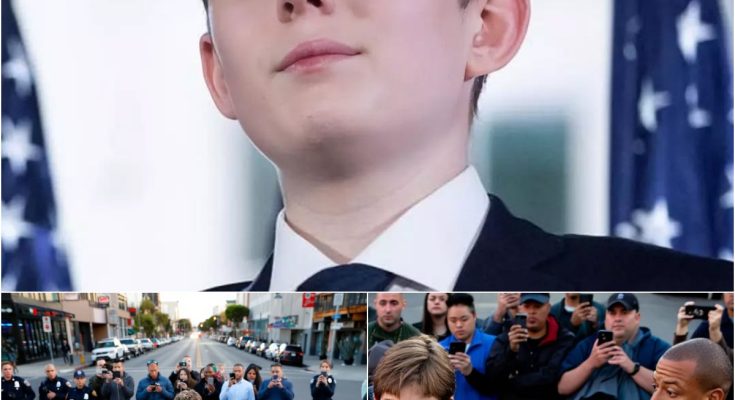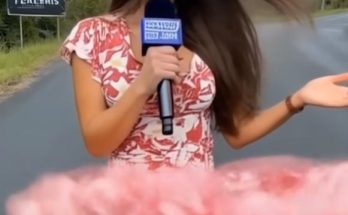Police Moved In on Barron Trump After Mistaken Identity—But What Happened Next Changed a City’s Conversation Forever
He wasn’t shouting. He wasn’t resisting. But for seven minutes, Barron Trump stood face-to-face with the full weight of suspicion. And when the truth came out, so did a conversation that shook an entire city to its core.
A Simple Afternoon Becomes Something Else
It was a quiet Wednesday in Oakland, California, and Barron Trump was walking alone near Lake Merritt, wearing a navy hoodie and plain jeans. The late afternoon sun filtered through tree canopies, dappling the sidewalks with shifting shadows.
Barron had flown in under the radar. No press. No staff. Just a visit to see a small youth arts center his foundation had quietly funded for over a year. After meeting the kids and sitting in on a poetry workshop, he had taken the long route back on foot to clear his mind.
He blended easily. That was part of the plan. When people didn’t recognize him, they spoke to him like anyone else—and that was rare, precious.
But as he passed a corner liquor store, the distant crackle of police radios and squealing tires split the air.
Two squad cars slammed to a stop across the street.
And everything changed.
“Don’t move. Show us your hands.”
Barron had no idea what was happening.
He instinctively stepped back—but not far. Just enough to understand what the four officers who leapt from their cars were doing.
Guns weren’t drawn. But hands were on holsters. And their voices weren’t uncertain.
“You. Hoodie. Step away from the wall. Now.”
One officer raised a hand to speak into his shoulder radio. “Black hoodie, jeans, white male—matches the description. Location confirmed.”
Barron raised his hands slowly.
“I’m not resisting,” he said, voice calm. “But I think you’ve got the wrong person.”
Seven Minutes of Stillness
“ID?” the officer barked.
Barron didn’t flinch. He carefully reached into his back pocket, slowly, showing his hand the entire time. “It’s in here.”
He passed the leather wallet over.
Another officer, a younger one, flipped it open—and froze.
“Sir… this is—”
The senior officer waved him off. “We don’t know that yet.”
Barron exhaled slowly. “You can call my assistant. Or the director of the arts center four blocks away.”
“We’ll verify.”
As they radioed for backup, the scene drew attention. A man from a nearby laundromat stepped out. Two teenagers on scooters stopped. Phones came out. Voices murmured.
“Wait—is that who I think it is?”
“Yo, they’re stopping Barron Trump?”
“No way. Why?”
The Allegation That Sparked It All
Moments earlier, an armed robbery had taken place just three blocks away. Witnesses described a young white male in a navy hoodie and dark jeans. The man had flashed something that looked like a weapon before sprinting down a side street.
In the confusion, someone had pointed toward the general direction Barron had been walking.
That was all it took.
The Crowd Grows—and So Does the Pressure
Barron stood still. Not a muscle moved. The weight of dozens of eyes—some sympathetic, some suspicious—fell on him.
A teenager shouted, “Leave him alone! That ain’t him!”
A woman nearby whispered, “If he wasn’t who he is, would they have already cuffed him?”
Barron said nothing.
He had learned early: silence can speak louder than panic.
But inside, his mind raced.
If this happened to me—with privilege, with a name—what would it feel like for someone without any of that?
Then: The Breakthrough
Just as one officer stepped forward with handcuffs in hand, a man came jogging up the sidewalk, waving his phone.
“Hold on! I just saw the guy who did it!”
He handed the phone to the younger officer. “Surveillance footage. From my store.”
On the screen, grainy footage showed a man—taller than Barron, bulkier, clearly older—running with a black duffel bag. The hoodie was a different brand. The shoes were red, not black.
The difference was clear.
The senior officer looked up, paused, and then stepped back.
“Mr. Trump… we apologize.”
A Moment That Could Have Gone Another Way
Barron didn’t yell.
He didn’t gloat.
He just exhaled, took back his ID, and said quietly, “Please be more certain next time.”
The crowd murmured.
One woman clapped once. Then again. And soon the plaza was filled with applause—not for celebrity, but for restraint.
What Happened After Went Deeper
Barron didn’t post about it.
But a clip—thirty-seven seconds long—made its way to social media.
It showed Barron standing calmly, breathing slowly, while two officers closed in. The caption read:
“He didn’t panic. He didn’t run. But if he had… what then?”
It was shared over 10 million times in 48 hours.
The City Responds
Within a week, the Oakland Police Department released a statement acknowledging the mistaken identity and praising Barron’s composure.
More importantly, they invited him to speak privately with a civilian oversight committee tasked with reviewing use-of-force and procedural training.
Barron accepted.
Behind Closed Doors, He Spoke Softly—But Clearly
In a closed meeting with city officials, youth advocates, and police reform leaders, Barron shared not just what happened, but how it made him feel.
He talked about:
The rush of adrenaline when officers surrounded him
The internal war between defending himself and staying still
The power of perception, and how quickly it shapes reality
And then he asked the room a question:
“If I weren’t who I am—what would’ve happened to me?”
What He Did Next Surprised Everyone
Barron didn’t sue. He didn’t call out the officers. He didn’t give speeches.
Instead, he launched a pilot program through his foundation:
“7 Minutes”—A Community Engagement Project
Aimed at:
Training youth on how to interact safely during police encounters
Teaching officers how unconscious bias shapes escalation
Funding body cameras and rapid ID verification tools for underfunded departments
Pairing artists and storytellers with police officers to co-create public installations about trust
The name? A reference to the time he stood still.
He Funded It Silently—But Made One Personal Request
That every participating officer hear directly from someone they once misjudged.
The first testimonial came from a former foster youth named Malik, who said:
“I didn’t have a last name anyone recognized. So I didn’t get seven minutes. I got two. And a record.”
How Barron’s Family Reacted
The story reached the Trump family quickly.
Sources say his father called immediately.
“You alright?”
“I am,” Barron replied.
“You were calm. Better than I would’ve been.”
“I was scared,” Barron admitted. “But someone had to stay calm. Might as well be me.”
And the Woman Who Filmed the Video?
Her name was April Lang, a local filmmaker who had been working on a documentary about public spaces.
She later said:
“I didn’t even realize who he was. I just saw a kid—scared, silent, but refusing to shrink.”
Barron met her weeks later. They talked for an hour.
She’s now directing a short film funded by the “7 Minutes” project, focused on perspective—how it changes lives, one decision at a time.
One Year Later: The Legacy
The project expanded to four more cities.
One police chief said, “It’s not about the name behind it. It’s about the mirror it holds up.”
Barron rarely attends the workshops.
But sometimes, quietly, he shows up. Sits in the back. Listens.
And always, at the end, he leaves the same note:



